Goldilocks Is Alive And Well
I am running to the airport in a few minutes, so I'll keep this brief and to the point. While the narrative in the stock market can change in the blink of an eye, it appears that Friday's Jobs report put the bulls back in control of the game.
The key word being used to describe the report is "Goldilocks." As in not hot enough to force additional Fed action and not cold enough to cause concern about the economy. No, this report was "just right" for the stock market.
More specifically, the number of new jobs created by the economy in February surprised to the upside (313,000 vs. expectations for around 265,000) while the wage growth data went the other way (average hourly earnings were up 2.6% vs. last month's "hot" reading of 2.9%) and the labor force participation rate surged.
Remember, it is the wage growth number that folks are focused on at the present time. While there will always be discussions about what causes inflation to rise (or in this case, not rise), I believe it is wage inflation that would push the data over the top and cause the Fed to potentially deviate from its current measured course. So, with the average hourly earnings data basically holding steady (see chart below), investors breathed a sigh of relief.
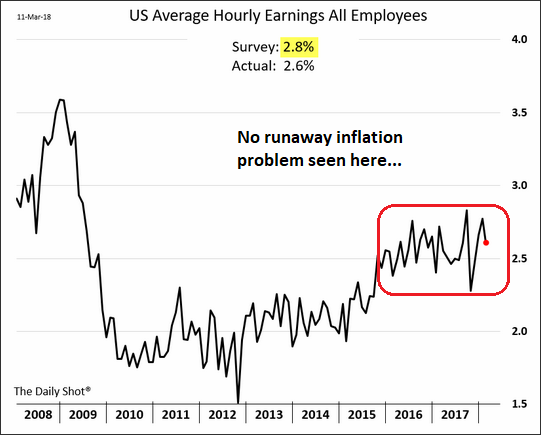
In looking at my market models/indicators this week, the key is the odds of the corrective phase being over seem to have once again advanced.
Sure, stocks could certainly trade in a wide range for several months. But the good news is that Friday's blast higher broke the downtrend line that had been in effect since the January 26 high water mark on the S&P 500. However, the bears are quick to point out that there is still important resistance at the 2787 area. Yet, at the same time, the fact that the NASDAQ and several tech groups closed at fresh new all-time highs would seem to bode well for the bulls going forward.
And if you want to skip to the bottom line, the historical return for the current state of my "primary cycle" models is 10.8% per year, which is above the mean of 8.9% seen over the past 37+ years.
Thus, I'm going to opine that the odds still favor the bulls here. And while the ride will surely be bumpy along the way, it appears that the dips should continue to be bought.
Publishing Note: I am traveling the rest of the week and will publish reports as my schedule permits.
Thought For The Day:
It's never too late - never too late to start over, never too late to be happy. -Jane Fonda
Wishing you green screens and all the best for a great day,

David D. Moenning
Founder, Chief Investment Officer
Heritage Capital Research
HCR Focuses on a Risk-Managed Approach to Investing
Must Read: What Risk Management Can and Cannot Do
HCR's Financial Advisor Services
HCR's Individual Investor Services
Questions, comments, or ideas? Contact Us
At the time of publication, Mr. Moenning held long positions in the following securities mentioned: None - Note that positions may change at any time.
The State of the Big-Picture Market Models
It's a new week, so let's start things off with a review of the state of my favorite big-picture market models, which are designed to tell us which team is in control of the prevailing major trend.

View My Favorite Market Models Online
Executive Summary:
- The long-term Leading Indicators model remains on a long-term buy signal, but the indicator level remains neutral for the third straight week.
- Our recently upgraded "State of the tape" model has improved within the positive mode and suggests the bulls should be given the benefit of doubt.
- The Risk/Reward model remains negative and on sell signal due to the emphasis on monetary conditions and sentiment.
- My "desert island" model combines trend, momentum, and external factors and remains on a long-term buy signal.
- The newly expanded External Factors model suggests that the cyclical bull trend remains intact.
- I wrote last week that while the major indices appeared to be in "retest mode," the indicators suggested that the bulls would likely prevail and that the dips should continue to be bought. So far, so good.
The State of the Trend
Digging into the details, I like to start my weekly review with a look at the "state of the trend." These indicators are designed to give us a feel for the overall health of the current short- and intermediate-term trend models.
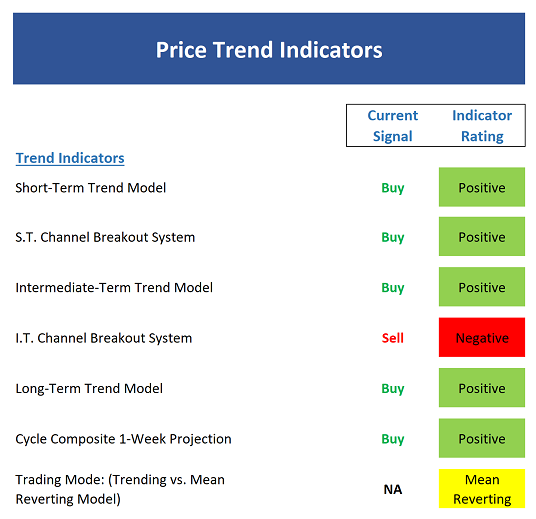
View Trend Indicator Board Online
Executive Summary:
- The "Goldilocks " Jobs report caused the short-term Trend Model to flip to positive And with our shorter-term ma now back above the 39- and 50-day mas the trend indicators have definitely improved.
- With stocks in a mean-reverting mode, the move on 3/5 2700 Monday produced a buy signal. This system will remain positive as long as the S&P remains above 2647.
- The intermediate-term Trend Model was able to reverse into the green last week.
- The intermediate-term Channel Breakout System remains on a sell signal. A close above 2789 would produce a new buy signal.
- The long-term Trend Model remains positive. As I've been saying every week, this is a reminder that we are experiencing a correction at this time - and not a bear market.
- The Cycle Composite points modestly higher this week but remains very choppy uptrend into late-March.
- From an intermediate-term perspective, the market remains in a mean-reverting mode.
- In sum, the trend improved last week as the major indices appear to be attempting a breakout above the important shorter-term resistance.
The State of Internal Momentum
Next up are the momentum indicators, which are designed to tell us whether there is any "oomph" behind the current trend.
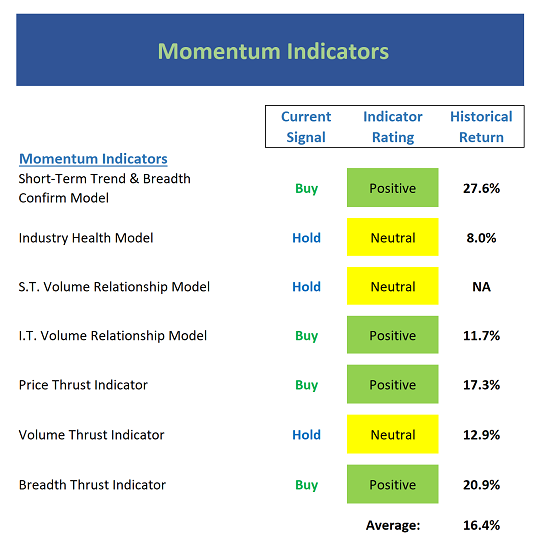
View Momentum Indicator Board Online
Executive Summary:
- The short-term Trend and Breadth Confirm Model flipped to positive last week. However, it is important to remember that this model has been in flip-flop mode for some time.
- The Industry Health Model remains in the neutral zone and the historical returns within this mode have been only slightly below the mean.
- The short-term Volume Relationship model improved nicely with last week's action, but remains neutral to start the week. Any further improvement will turn the indicator positive.
- The intermediate-term Volume Relationship Model remains positive and is another indication that this remains a bull market until proven otherwise.
- The intermediate-term Price Thrust Indicator produces a buy signal last week, which bodes well for the bulls going forward. Remember, with the stage set for the bulls to resume, we've been looking for some "oomph" from the bulls to confirm the reversal.
- The Volume Thrust Indicator starts the week in the neutral zone. We would really like to this indicator flash a fresh buy signal.
- The Breadth Thrust Indicator improved last week and remains on the 2/23 buy signal.
- Market momentum definitely improved last week. If we could get a wee bit more "thrust" we could declare an "all clear" signal. But so far, we are a bit short of such a declaration.
The State of the "Trade"
We also focus each week on the "early warning" board, which is designed to indicate when traders might start to "go the other way" -- for a trade.
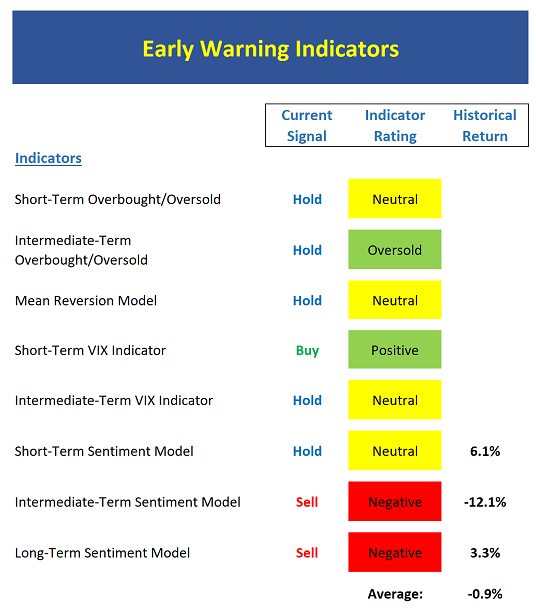
View Early Warning Indicator Board Online
Executive Summary:
- From a near-term perspective, stocks are neither overbought or oversold. Solidly neutral here.
- From an intermediate-term view, stocks remain modestly oversold. This, when combined with the neutral position from the s.t. indicators suggest the bulls have some room to run.
- The Mean Reversion Model will be closing out its 2/14 buy signal on Monday and going flat.
- The short-term VIX indicator has produced a very timely sell and buy signal of late. Note that this system is now getting close to the sell zone.
- With VIX levels remaining elevated, our intermediate-term VIX signal is currently "adjusting" to the new environment.
- From a short-term perspective, market sentiment is now back to neutral.
- No change. The intermediate-term Sentiment Model remains in the red zone to start the week.
- The Long-Term Sentiment Model reading remains modestly negative. The good news is the extreme optimism readings have been worked off.
The State of the Macro Picture
Now let's move on to the market's "external factors" - the indicators designed to tell us the state of the big-picture market drivers including monetary conditions, the economy, inflation, and valuations.
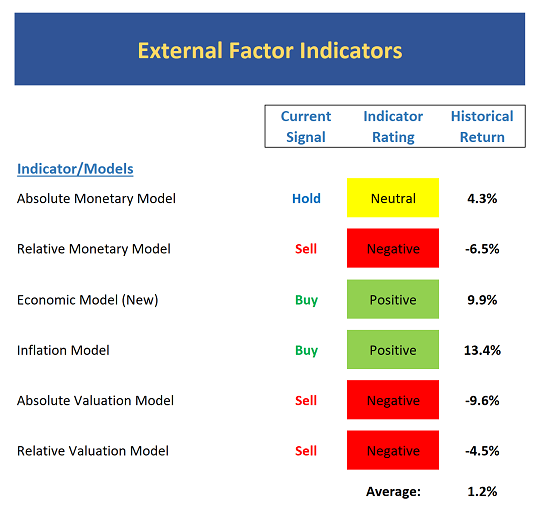
View External Factors Indicator Board Online
Executive Summary:
- The Absolute Monetary model continues to hover near the sell zone but has not yet produced a negative signal.
- The Relative Monetary Model continues to move lower in negative territory and on a sell signal.
- The Economic Model has been holding steady and continues to suggest a strong economic environment and decent equity returns.
- As I've been saying, the Inflation Model remains positive and a long way from suggesting high inflationary pressures.
- There is no change to the Absolute Valuation situation. Our model is negative and the reading is at the worst levels since the crisis ended.
- Our Relative Valuation Model continues to act as a warning flag.
Sample Tactical Allocation Model
Below is an EXAMPLE (and ONLY an EXAMPLE) of how one might incorporate the indicator boards. The approach shown below is designed to provide the current equity allocation for a balanced tactical asset allocation model with a base target of 60/40 stocks/bonds.
The overall intent of the model is to keep equity exposure in line with current conditions.
Beginning February 2018, the model will be updated monthly.
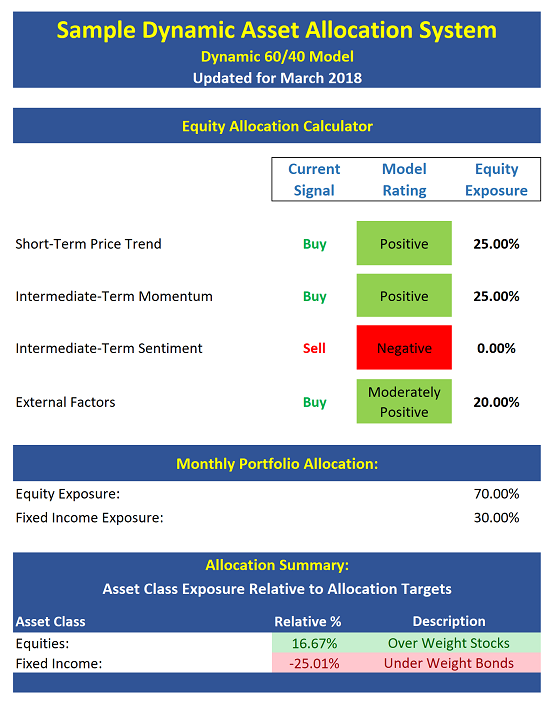
The model above is for illustrative and informational purposes only and does not in any way represent any investment recommendation. The model is merely a sample of how indicators can be grouped to create a guide to market exposure based on the inputs from multiple indicators/models.
Indicators Explained
Short-Term Trend-and-Breadth Signal Explained: History shows the most reliable market moves tend to occur when the breadth indices are in gear with the major market averages. When the breadth measures diverge, investors should take note that a trend reversal may be at hand. This indicator incorporates NDR's All-Cap Dollar Weighted Equity Series and A/D Line. From 1998, when the A/D line is above its 5-day smoothing and the All-Cap Equal Weighted Equity Series is above its 25-day smoothing, the equity index has gained at a rate of +32.5% per year. When one of the indicators is above its smoothing, the equity index has gained at a rate of +13.3% per year. And when both are below, the equity index has lost +23.6% per year.
Channel Breakout System Explained: The short-term and intermediate-term Channel Breakout Systems are modified versions of the Donchian Channel indicator. According to Wikipedia, "The Donchian channel is an indicator used in market trading developed by Richard Donchian. It is formed by taking the highest high and the lowest low of the last n periods. The area between the high and the low is the channel for the period chosen."
Intermediate-Term Trend-and-Breadth Signal Explained: This indicator incorporates NDR's All-Cap Dollar Weighted Equity Series and A/D Line. From 1998, when the A/D line is above its 45-day smoothing and the All-Cap Equal Weighted Equity Series is above its 45-day smoothing, the equity index has gained at a rate of +17.6% per year. When one of the indicators is above its smoothing, the equity index has gained at a rate of +6.5% per year. And when both are below, the equity index has lost -1.3% per year.
Industry Health Model Explained: Designed to provide a reading on the technical health of the overall market, Big Mo Tape takes the technical temperature of more than 100 industry sectors each week. Looking back to early 1980, when the model is rated as "positive," the S&P has averaged returns in excess of 23% per year. When the model carries a "neutral" reading, the S&P has returned over 11% per year. But when the model is rated "negative," stocks fall by more than -13% a year on average.
Cycle Composite Projections: The cycle composite combines the 1-year Seasonal, 4-year Presidential, and 10-year Decennial cycles. The indicator reading shown uses the cycle projection for the upcoming week.
Trading Mode Indicator: This indicator attempts to identify whether the current trading environment is "trending" or "mean reverting." The indicator takes the composite reading of the Efficiency Ratio, the Average Correlation Coefficient, and Trend Strength models.
Volume Relationship Models: These models review the relationship between "supply" and "demand" volume over the short- and intermediate-term time frames.
Price Thrust Model Explained: This indicator measures the 3-day rate of change of the Value Line Composite relative to the standard deviation of the 30-day average. When the Value Line's 3-day rate of change have moved above 0.5 standard deviation of the 30-day average ROC, a "thrust" occurs and since 2000, the Value Line Composite has gained ground at a rate of +20.6% per year. When the indicator is below 0.5 standard deviation of the 30-day, the Value Line has lost ground at a rate of -10.0% per year. And when neutral, the Value Line has gained at a rate of +5.9% per year.
Volume Thrust Model Explained: This indicator uses NASDAQ volume data to indicate bullish and bearish conditions for the NASDAQ Composite Index. The indicator plots the ratio of the 10-day total of NASDAQ daily advancing volume (i.e., the total volume traded in stocks which rose in price each day) to the 10-day total of daily declining volume (volume traded in stocks which fell each day). This ratio indicates when advancing stocks are attracting the majority of the volume (readings above 1.0) and when declining stocks are seeing the heaviest trading (readings below 1.0). This indicator thus supports the case that a rising market supported by heavier volume in the advancing issues tends to be the most bullish condition, while a declining market with downside volume dominating confirms bearish conditions. When in a positive mode, the NASDAQ Composite has gained at a rate of +38.3% per year, When neutral, the NASDAQ has gained at a rate of +13.3% per year. And when negative, the NASDAQ has lost at a rate of -8.5% per year.
Breadth Thrust Model Explained: This indicator uses the number of NASDAQ-listed stocks advancing and declining to indicate bullish or bearish breadth conditions for the NASDAQ Composite. The indicator plots the ratio of the 10-day total of the number of stocks rising on the NASDAQ each day to the 10-day total of the number of stocks declining each day. Using 10-day totals smooths the random daily fluctuations and gives indications on an intermediate-term basis. As expected, the NASDAQ Composite performs much better when the 10-day A/D ratio is high (strong breadth) and worse when the indicator is in its lower mode (weak breadth). The most bullish conditions for the NASDAQ when the 10-day A/D indicator is not only high, but has recently posted an extreme high reading and thus indicated a thrust of upside momentum. Bearish conditions are confirmed when the indicator is low and has recently signaled a downside breadth thrust. In positive mode, the NASDAQ has gained at a rate of +22.1% per year since 1981. In a neutral mode, the NASDAQ has gained at a rate of +14.5% per year. And when in a negative mode, the NASDAQ has lost at a rate of -6.4% per year.
Short-Term Overbought/sold Indicator: This indicator is the current reading of the 14,1,3 stochastic oscillator. When the oscillator is above 80 and the %K is above the %D, the indicator gives an overbought reading. Conversely, when the oscillator is below 20 and %K is below its %D, the indicator is oversold.
Intermediate-Term Overbought/sold Indicator: This indicator is a 40-day RSI reading. When above 57.5, the indicator is considered overbought and when below 45 it is oversold.
Mean Reversion Model: This is a diffusion model consisting of five indicators that can produce buy and sell signals based on overbought/sold conditions.
VIX Indicator: This indicator looks at the current reading of the VIX relative to standard deviation bands. When the indicator reaches an extreme reading in either direction, it is an indication that a market trend could reverse in the near-term.
Short-Term Sentiment Indicator: This is a model-of-models composed of 18 independent sentiment indicators designed to indicate when market sentiment has reached an extreme from a short-term perspective. Historical analysis indicates that the stock market's best gains come after an environment has become extremely negative from a sentiment standpoint. Conversely, when sentiment becomes extremely positive, market returns have been subpar.
Intermediate-Term Sentiment Indicator: This is a model-of-models composed of 7 independent sentiment indicators designed to indicate when market sentiment has reached an extreme from an intermediate-term perspective. Historical analysis indicates that the stock market's best gains come after an environment has become extremely negative from a sentiment standpoint. Conversely, when sentiment becomes extremely positive, market returns have been subpar.
Long-Term Sentiment Indicator: This is a model-of-models composed of 6 independent sentiment indicators designed to indicate when market sentiment has reached an extreme from a long-term perspective. Historical analysis indicates that the stock market's best gains come after an environment has become extremely negative from a sentiment standpoint. Conversely, when sentiment becomes extremely positive, market returns have been subpar.
Absolute Monetary Model Explained: The popular cliché, "Don't fight the Fed" is really a testament to the profound impact that interest rates and Fed policy have on the market. It is a proven fact that monetary conditions are one of the most powerful influences on the direction of stock prices. The Absolute Monetary Model looks at the current level of interest rates relative to historical levels and Fed policy.
Relative Monetary Model Explained: The "relative" monetary model looks at monetary indicators relative to recent levels as well as rates of change and Fed Policy.
Economic Model Explained: During the middle of bull and bear markets, understanding the overall health of the economy and how it impacts the stock market is one of the few truly logical aspects of the stock market. When our Economic model sports a "positive" reading, history (beginning in 1965) shows that stocks enjoy returns in excess of 21% per year. Yet, when the model's reading falls into the "negative" zone, the S&P has lost nearly -25% per year. However, it is vital to understand that there are times when good economic news is actually bad for stocks and vice versa. Thus, the Economic model can help investors stay in tune with where we are in the overall economic cycle.
Inflation Model Explained: They say that "the tape tells all." However, one of the best "big picture" indicators of what the market is expected to do next is inflation. Simply put, since 1962, when the model indicates that inflationary pressures are strong, stocks have lost ground. Yet, when inflationary pressures are low, the S&P 500 has gained ground at a rate in excess of 13%. The bottom line is inflation is one of the primary drivers of stock market returns.
Valuation Model Explained: If you want to get analysts really riled up, you need only to begin a discussion of market valuation. While the question of whether stocks are overvalued or undervalued appears to be a simple one, the subject is extremely complex. To simplify the subject dramatically, investors must first determine if they should focus on relative valuation (which include the current level of interest rates) or absolute valuation measures (the more traditional readings of Price/Earnings, Price/Dividend, and Price/Book Value). We believe that it is important to recognize that environments change. And as such, the market's focus and corresponding view of valuations are likely to change as well. Thus, we depend on our Valuation Models to help us keep our eye on the ball.
Disclosures
The opinions and forecasts expressed herein are those of Mr. David Moenning and may not actually come to pass. Mr. Moenning's opinions and viewpoints regarding the future of the markets should not be construed as recommendations. The analysis and information in this report is for informational purposes only. No part of the material presented in this report is intended as an investment recommendation or investment advice. Neither the information nor any opinion expressed constitutes a solicitation to purchase or sell securities or any investment program.
Any investment decisions must in all cases be made by the reader or by his or her investment adviser. Do NOT ever purchase any security without doing sufficient research. There is no guarantee that the investment objectives outlined will actually come to pass. All opinions expressed herein are subject to change without notice. Neither the editor, employees, nor any of their affiliates shall have any liability for any loss sustained by anyone who has relied on the information provided.
Mr. Moenning may at times have positions in the securities referred to and may make purchases or sales of these securities while publications are in circulation. Positions may change at any time.
The analysis provided is based on both technical and fundamental research and is provided "as is" without warranty of any kind, either expressed or implied. Although the information contained is derived from sources which are believed to be reliable, they cannot be guaranteed.
Investments in equities carry an inherent element of risk including the potential for significant loss of principal. Past performance is not an indication of future results.
